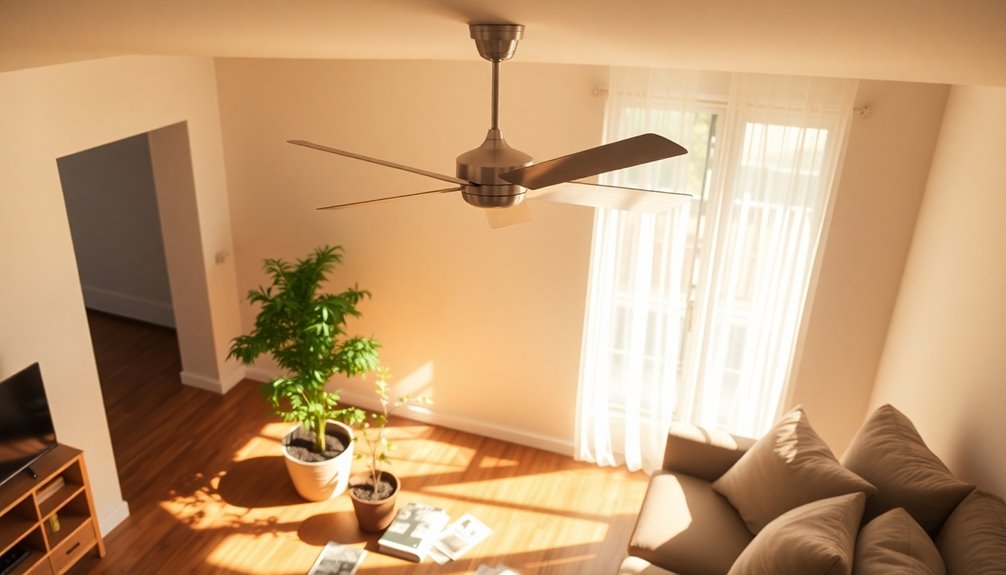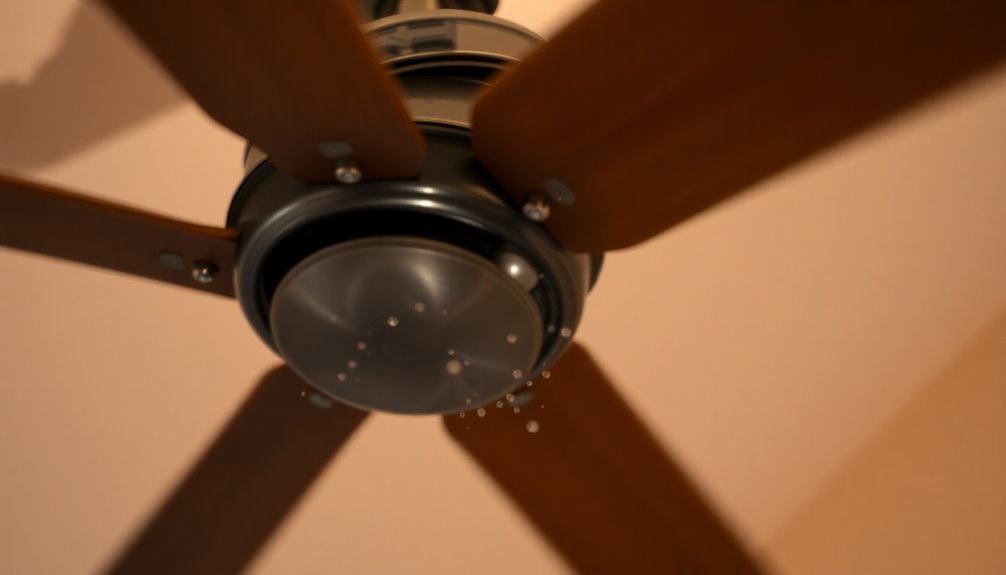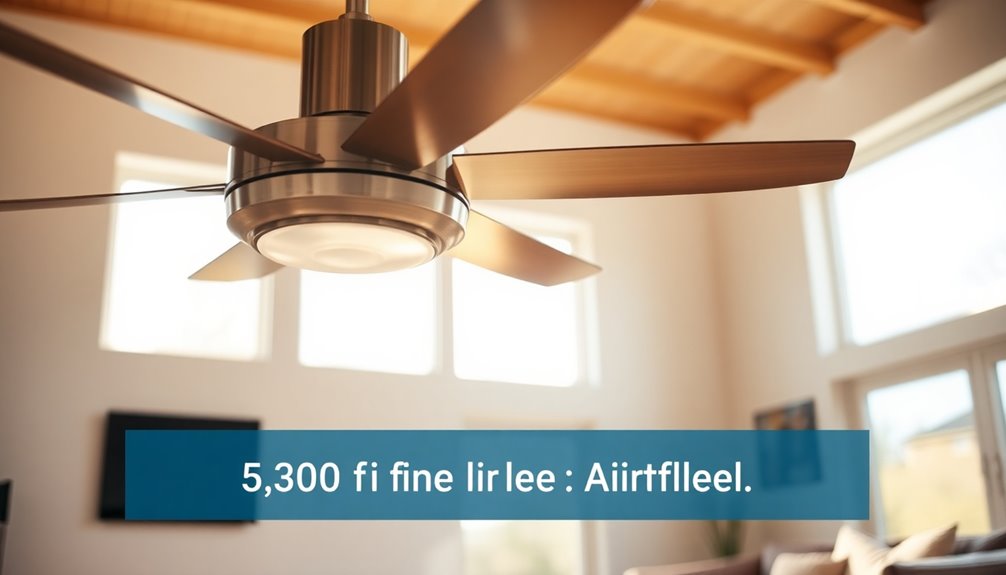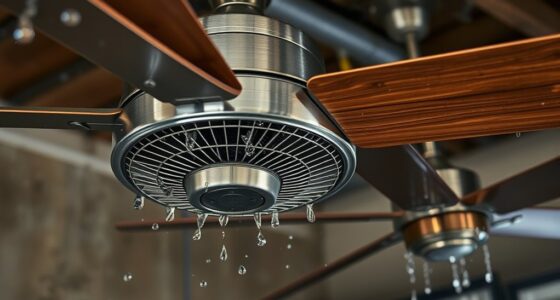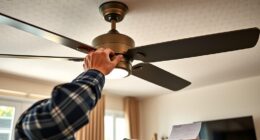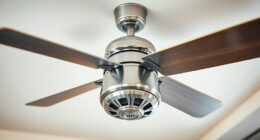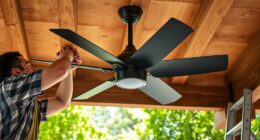You can leave a ceiling fan on for hours without worry, but it isn't always the best choice for energy efficiency. While ceiling fans are safe for extended use, it's smart to turn them off when you leave a room to save energy and reduce unnecessary costs. They circulate air, enhancing comfort, but they don't actually cool the room. Regular maintenance is also essential for peak performance and safety. If you're curious about maximizing your fan's effectiveness and understanding when to use it, there's more insightful information to explore.
Key Takeaways
- Ceiling fans can be left on for extended periods, but it's best to turn them off when not in use to save energy.
- Continuous operation may lead to unnecessary wear and tear on fan components, impacting longevity.
- Using a ceiling fan in conjunction with air conditioning allows for higher thermostat settings, improving energy efficiency.
- Regular maintenance, such as cleaning and lubricating, helps ensure safe and effective long-term use of ceiling fans.
- Programmable thermostats can help optimize fan usage and cooling without needing to leave the fan running all day.
Safety Considerations for Ceiling Fans

When it comes to ceiling fans, prioritizing safety is vital. High-quality ceiling fans are designed for safe extended use, especially when installed by a professional electrician. This minimizes fire risks, so make certain you have a qualified expert handle the installation.
While it's safe to leave ceiling fans on for hours, best practices suggest turning them off when you leave a room. This not only enhances energy efficiency but also adds an extra layer of safety. Additionally, ensuring proper indoor air quality can further improve your comfort level while using ceiling fans.
Regular maintenance is important; keep an eye out for dust accumulation, which can lead to electrical hazards. Cleaning and inspecting your ceiling fans can prevent these risks.
If you notice unusual noises, like clicking or grinding, don't ignore them. These sounds often indicate a need for professional inspection to guarantee both safety and peak performance.
Benefits of Continuous Operation

Keeping your ceiling fan running continuously can greatly enhance air circulation, making your indoor environment more comfortable.
You'll likely notice improved sleep quality as the gentle airflow and white noise help drown out distractions.
Plus, it's a smart way to maintain a pleasant temperature without racking up high energy bills.
Enhanced Air Circulation
A ceiling fan running continuously can greatly enhance the air circulation in your space, leading to improved indoor air quality and reduced humidity levels. When you keep the ceiling fan running, it promotes proper airflow, helping to maintain a comfortable temperature by distributing heat evenly throughout the room. This means you won't have to rely solely on your air conditioning, which can save you money in the long run. Additionally, incorporating a commercial grade heat pump with your ceiling fan can further optimize energy efficiency in larger spaces.
Moreover, the energy efficiency of a ceiling fan running is a major benefit. It typically uses only 15 to 90 watts, considerably less than an air conditioning unit. By allowing your ceiling fan to run, you can raise your thermostat settings during warmer months, further reducing your energy consumption.
Furthermore, the gentle white noise generated by a ceiling fan can mask disruptive sounds in your environment, contributing to overall comfort. This not only makes your space feel more inviting but also helps you remain focused on tasks or enjoy relaxation. Maintaining good air circulation with a ceiling fan can complement the use of air purifiers by enhancing their effectiveness in reducing pollutants and improving air quality.
Improved Sleep Quality
Throughout the night, a ceiling fan can greatly boost your sleep quality by creating a comfortable sleeping environment. When you leave it running, you benefit from several factors that contribute to improved sleep quality:
- Enhanced air circulation keeps the air fresh and breathable, helping you fall asleep faster.
- White noise produced by the fan masks disruptive sounds, allowing you to enjoy deeper, more restful sleep.
- Temperature regulation promotes the evaporation of sweat, making it easier to stay asleep, especially during warmer nights.
- Gentle airflow prevents overheating, ensuring that you remain comfortable throughout the night.
Research shows that improved air circulation from ceiling fans can lead to longer sleep durations and better sleep efficiency. Additionally, maintaining a comfortable environment can also help minimize disturbances from external noise factors, which is essential for uninterrupted sleep.
By creating an ideal sleep environment, you set the stage for a more rejuvenating night.
So, if you're struggling to get quality rest, consider letting your ceiling fan run while you sleep.
You'll likely notice the positive impact on your overall sleep quality, making it a simple yet effective addition to your nightly routine.
Energy Efficiency Insights

While ceiling fans are a great way to enhance comfort, it's important to understand their energy use to maximize efficiency. Ceiling fans typically consume between 15 to 90 watts of electricity, making them markedly more energy-efficient than air conditioning units. In fact, studies show that using security systems can also contribute to overall energy savings by optimizing home energy use.
However, leaving a ceiling fan on all day can actually increase your energy costs because fans are meant to provide comfort rather than lower room temperatures. Additionally, using ceiling fans in conjunction with heat pumps can significantly improve overall comfort levels in your home.
To gain valuable energy efficiency insights, consider using your fan in short bursts. These brief periods of use are more effective for cooling and conserving energy compared to running the fan continuously throughout the day. Pairing your ceiling fan with a programmable thermostat can further optimize cooling without needing the fan on all the time.
Additionally, remember to turn off your ceiling fan when you leave a room. Even though they use less energy than air conditioners, fan motors generate heat, which can be counterproductive in unoccupied spaces. Furthermore, using ceiling fans in conjunction with heat pumps and indoor air quality can enhance both comfort and energy efficiency in your home.
Smart Usage Tips

Using your ceiling fan smartly can considerably enhance both comfort and energy efficiency. To get the most out of your ceiling fan while minimizing wear and tear, follow these smart usage tips:
- Turn off fans when leaving a room: This helps conserve energy and reduces unnecessary wear on components.
- Use programmable timers: Set your fan to operate only when you're around. This prevents fans running in unoccupied spaces, which can generate heat and lead to overheating.
- Take regular breaks: Continuous operation can strain your fan. Allow it to rest periodically to prolong its lifespan.
- Perform regular maintenance: Cleaning and balancing your fan guarantees it operates efficiently and safely over time, preventing potential issues.
- Maintain a clean environment: A tidy space can reduce allergens and pollutants, thereby enhancing the overall efficiency of your ceiling fan and improving air quality.
Common Misunderstandings

You might think ceiling fans actually cool the air, but they don't—they just circulate it to help you feel cooler.
Many people also believe that leaving a fan on all the time will lower the room temperature, which isn't true.
Understanding these common misunderstandings can help you use your ceiling fan more effectively.
Fan Cooling Mechanism Misconception
Many homeowners hold a common misconception about ceiling fans: they believe these appliances actually lower room temperatures. In reality, ceiling fans don't cool the air; they circulate it, creating a cooling effect on your skin through the evaporation of sweat. This fan cooling mechanism misconception can lead to unnecessary energy use and discomfort when the fans are left on in unoccupied rooms.
To clarify how ceiling fans work, consider these points:
- They enhance comfort when you're present, not the room's temperature.
- Using them alongside air conditioning allows for higher thermostat settings.
- Adjusting the fan's rotation seasonally maximizes efficiency.
- Turning off fans when no one's in the room saves energy. Additionally, using ceiling fans can help create a more enjoyable atmosphere in your living space.
- Understanding the role of airflow can help optimize your comfort levels and reduce reliance on cooling systems.
Understanding that ceiling fans can't cool a room is vital for making informed decisions about their use.
When you grasp this, you'll not only improve your comfort but also reduce energy costs.
Continuous Use Effects
Leaving a ceiling fan on continuously can lead to a host of misunderstandings regarding its effects on both comfort and energy consumption. Many homeowners mistakenly believe that running a fan all day cools the room. In reality, fans only circulate air, creating a cooling effect on your body without lowering the actual temperature.
Additionally, while ceiling fans are generally safe for prolonged use, overuse can reduce their lifespan due to heat generated by the motor. You may also face higher energy costs, as these fans consume between 15-90 watts. If you leave them on unnecessarily, those costs can add up.
To clarify these continuous use effects, here's a quick breakdown:
| Misunderstanding | Reality | Impact |
|---|---|---|
| Fans cool the room | Fans only circulate air | No temperature reduction |
| Can replace air conditioning | Fans complement AC for better circulation | Ineffective cooling alone |
| Overuse doesn't affect lifespan | Prolonged use can diminish fan life | Increased maintenance needed |
| Energy costs remain constant | Continuous use increases energy bills | Higher utility expenses |
Understanding these points helps you make more informed decisions about using your ceiling fan.
Ideal Usage Practices
Understanding ideal usage practices for ceiling fans can help dispel common misunderstandings that lead to inefficient use. Many people think ceiling fans cool the air, but they actually circulate it, enhancing the evaporation of sweat on your skin to create a cooling effect.
Here are some key points to keep in mind for best fan usage:
- Turn it off when you leave: Leaving a fan on in an empty room is unnecessary since it doesn't lower the room temperature.
- Use in conjunction with AC: Ceiling fans are designed to complement air conditioning, not replace it. They work best together for maximum comfort.
- Know the direction: Operate your fan counterclockwise in summer to push cool air down and clockwise in winter to circulate warm air.
- Consider wear and tear: Though high-quality ceiling fans are designed for extended use, continuous operation can wear down components, reducing their lifespan.
Maintenance Best Practices

Maintaining your ceiling fan is vital for guaranteeing its efficiency and longevity. Start by regularly cleaning the blades to prevent dust buildup, which can decrease performance and lead to electrical issues. Use a damp cloth to wipe them down and keep your fan running smoothly.
Next, inspect your fan for any unusual noises or wobbling. These can indicate that it needs balancing or professional maintenance. If you notice these signs, don't hesitate to reach out to electrical services for help.
It's also important to lubricate the fan motor according to the manufacturer's instructions. This step maintains peak performance and extends the lifespan of your fan.
Additionally, check the electrical connections periodically to prevent any loose wiring, which could pose safety hazards.
Lastly, schedule professional inspections at least once a year. This guarantees that your fan operates safely and efficiently, catching any potential issues before they become significant problems.
Optimal Fan Settings

After ensuring your ceiling fan is in good condition, it's time to focus on its settings for ideal performance.
Choosing the best fan settings can greatly enhance your comfort while saving energy throughout the year.
Here's how to adjust your fan for different seasons:
- Summer: Set your fan to spin counterclockwise. This pushes cool air down, creating a revitalizing breeze.
- Winter: Reverse the fan direction to clockwise. This helps circulate warm air trapped near the ceiling, making your space feel warmer.
- Energy Savings: Utilize your fan instead of relying solely on air conditioning. Fans circulate air rather than changing room temperature, helping to reduce energy costs.
- Regular Adjustments: Frequently check and adjust fan settings based on seasonal needs to maintain peak efficiency and comfort.
Choosing the Right Electrician

When it comes to installing a ceiling fan, choosing the right electrician is vital for guaranteeing a safe and effective setup. Start by looking for licensed electricians who specialize in residential electrical work. Their experience assures quality and safety during your installation.
Next, check customer reviews and ratings. A reputable electrician should have positive feedback, ideally with over 300 five-star reviews that reflect high customer satisfaction. This can give you confidence in their ability to meet your needs.
Before any work begins, make certain the electrician provides clear, upfront pricing. This helps you avoid unexpected costs during the installation process.
It's also important to verify that they adhere to local safety and compliance standards, minimizing fire risks associated with electrical installations.
Finally, opt for electricians who offer a warranty or guarantee on their work. This provides peace of mind regarding the quality and durability of the installation.
Frequently Asked Questions
Is It Okay to Leave a Ceiling Fan on 24/7?
Yes, it's okay to leave a ceiling fan on 24/7, as long as it's installed and maintained properly.
However, keep in mind that continuous use can wear out the components faster. While it doesn't directly cool the air, it helps circulate it, so consider turning it off when you leave the room.
Regular maintenance, like cleaning and checking for noises, will guarantee your fan runs smoothly for as long as you need it.
How Much Time Can a Ceiling Fan Run Continuously?
You can run a ceiling fan continuously for several hours without any issues if it's a quality model installed correctly.
Budget fans mightn't be as durable, so it's best to check their specifications.
While it's okay for the fan to run all day, turning it off when you leave a room helps conserve energy and prolongs its lifespan.
Regular breaks are smart to prevent overheating and reduce wear on the motor.
Do Ceiling Fans Overheat?
Yes, ceiling fans can overheat, especially if they're of lower quality or not properly maintained.
You should regularly clean and balance your fan to prevent overheating issues. High-quality fans usually have built-in thermal protection, allowing them to run safely for extended periods.
If you hear unusual noises like clicking or grinding, it might be a sign of potential overheating, so you should get it inspected by a professional.
Is It OK to Leave My Fan on All Night?
Did you know that running a ceiling fan can improve sleep quality by up to 42%?
It's definitely okay to leave your fan on all night, especially if it's a high-quality model. The airflow helps create a comfortable sleeping environment.
However, remember to turn it off when you leave the room to save energy and extend its lifespan.
Regular maintenance, like cleaning, keeps your fan running quietly and efficiently.
Conclusion
To sum up, leaving your ceiling fan on for extended periods is generally safe, but it's important to take into account energy efficiency and comfort. The theory that fans cool a room isn't quite right; they cool people by creating a wind-chill effect. So, when you leave, turn it off to save energy. By understanding how to use your ceiling fan wisely, you can enjoy its benefits while keeping your energy bills in check. Happy cooling!
